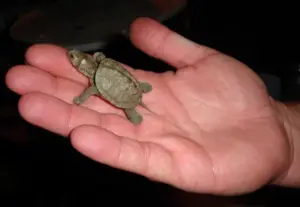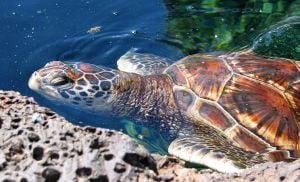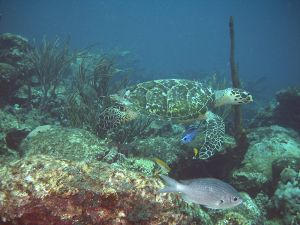Difference between revisions of "Turtle" - New World Encyclopedia
Rick Swarts (talk | contribs) |
Rick Swarts (talk | contribs) |
||
| Line 37: | Line 37: | ||
The largest known chelonian in the fossil record was ''Archelon ischyros'', a [[Cretaceous|Late Cretaceous]] sea turtle known to have been up to 4.6 meters (15 feet) long (Everhart 2007). | The largest known chelonian in the fossil record was ''Archelon ischyros'', a [[Cretaceous|Late Cretaceous]] sea turtle known to have been up to 4.6 meters (15 feet) long (Everhart 2007). | ||
| − | + | The smallest turtle is the [[speckled padloper tortoise]] of [[South Africa]]. It measures no more than 8 centimeters (3 inches) in length and weighs about 140 grams (5 ounces). Two other species of small turtles are the American [[mud turtle]]s and [[musk turtle]]s that live in an area that ranges from [[Canada]] to [[South America]]. The shell length of many species in this group is less than 13 centimeters (5 inches) in length. | |
| − | The smallest turtle is the [[speckled padloper tortoise]] of South Africa. It measures no more than 8 | ||
===Neck folding=== | ===Neck folding=== | ||
| − | Turtles are broken down into two groups, according to how they evolved a solution to the problem of withdrawing their neck into their shell | + | Turtles are broken down into two groups, according to how they evolved a solution to the problem of withdrawing their neck into their shell. In most turtles, the [[Cryptodira]], the neck is folding under their spine, being drawn directly back into the shell in a S-shaped curve. In the remainder, the [[Pleurodira]], or side-necked turtles, the neck is tucked next to the shoulder. Ancestral turtles are believed to have not been able to retract their neck. |
| − | + | [[Image:Snapping turtle 3 md.jpg|thumb|right|300px|Closeup head-on view of a common snapping turtle (''[[Chelydra serpentina]]''), taken near the St. Lawrence River in northern New York State]] | |
===Head=== | ===Head=== | ||
| − | Most | + | Most turtles that spend most of their life on land have their eyes looking down at objects in front of them. Some aquatic turtles, such as snapping turtles and soft-shelled turtles, have eyes closer to the top of the head. These species of turtles can hide from predators in shallow water where they lie entirely submerged except for their eyes and nostrils. Sea turtles possess glands near their eyes that produce salty tears that rid their body of excess [[salt]] taken in from the water they drink. |
| − | turtles that spend most of their life on land have their eyes looking down at objects in front of them. Some aquatic turtles, such as snapping turtles and soft-shelled turtles, have eyes closer to the top of the head. These species of turtles can hide from predators in shallow water where they lie entirely submerged except for their eyes and nostrils. Sea turtles possess glands near their eyes that produce salty tears that rid their body of excess [[salt]] taken in from the water they drink. | ||
Turtles are thought to have exceptional night vision due to the unusually large amount of [[rod cells]] in their retinas. Normal daytime vision is marginal at best due to their color-blindness and poor visual acuity. In addition to daytime vision problems, turtles have very poor [[pursuit movement]] abilities, which are normally reserved for predators that hunt quick moving prey. Carnivorous turtles can move their heads quickly to snap though. | Turtles are thought to have exceptional night vision due to the unusually large amount of [[rod cells]] in their retinas. Normal daytime vision is marginal at best due to their color-blindness and poor visual acuity. In addition to daytime vision problems, turtles have very poor [[pursuit movement]] abilities, which are normally reserved for predators that hunt quick moving prey. Carnivorous turtles can move their heads quickly to snap though. | ||
Revision as of 19:54, 2 June 2007
| Turtles
| ||||||||
|---|---|---|---|---|---|---|---|---|
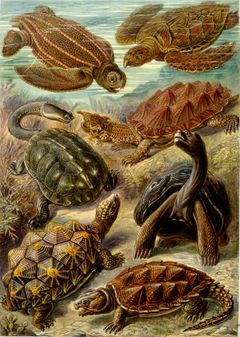 "Chelonia" from Ernst Haeckel's Kunstformen der Natur, 1904
| ||||||||
| Scientific classification | ||||||||
| ||||||||
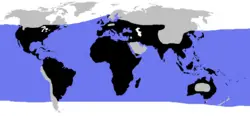 blue: sea turtles, black: land turtles
| ||||||||
|
Cryptodira |
Turtle is any aquatic or terrestrial reptile of the order Testudines (or Chelonia), characterized by toothless jaws with horny beaks and generally having a body shielded by a special bony or cartilagenous shell. Tortoise and terrapin are the names for two sub-groups commonly recognized within Testudines. Tortoise is the common name for any land-dwelling turtle, especially those belonging to the family Testudinidae. Terrapin is the common name for large freshwater or brackish water turtles belonging to the family Emydidae, especially the genus Malaclemys and sometimes the genus Pseudemys (or Chrysemys).
Not all turtles (also known as chelonians) have armorlike shells. The Trionychidae family has members commonly referred to as "softshell turtles," because their carapace lacks scutes (scales), such as the North American genus Apalone. The Australasian pig-nose turtle, Carettochelys insculpta, found in New Guinea and Australia and also known as the "plateless turtle," is a species of soft-shelled turtle whose gray carapace has a leathery texture. The leatherback sea turtle (Dermochelys coriacea), found in all tropical and subtropical oceans, has a shell that lacks the bony scutes of other turtles, comprising mainly connective tissue.
About 300 species of turtles are alive today, many of which are rare or endangered. They are found in most parts of the world. Turtles are ectothermic or cold-blooded, which means that their body temperature changes with their environment.
Anatomy and morphology
Turtles vary widely in size, although marine turtles tend to be relatively bigger animals than their land and freshwater relatives.
The largest extant turtle is a marine turtle, the great leatherback sea turtle, which reaches a shell length of over 2.7 meters (8.8 feet) and weight of 900 kilograms (kg) (2,000 lb)—the world's fourth largest reptile, behind the larger crocodiles. Freshwater turtles are generally smaller, but with the largest species, the Asian softshell turtle Pelochelys cantorii, a few individuals have been reported to measure up to 200 centimeters or 80 inches (Das 1991). This dwarfs even the better-known alligator snapping turtle, the largest chelonian in North America, which attains a shell length of up to 80 centimeters (31½ inches) and a weight of about 60 kg (170 lb).
Giant tortoises of the genera Geochelone, Meiolania, and others were relatively widely distributed around the world into prehistoric times, and are known to have existed in North and South America, Australia, and Africa. They became extinct at the same time as the appearance of humans, and it is assumed that humans hunted them for food. The only surviving giant tortoises are on the Seychelles and Galápagos Islands and can grow to over 130 cenimeters (50 inches) in length, and weigh about 300 kg (670 lb) (Connor 2007).
The largest known chelonian in the fossil record was Archelon ischyros, a Late Cretaceous sea turtle known to have been up to 4.6 meters (15 feet) long (Everhart 2007).
The smallest turtle is the speckled padloper tortoise of South Africa. It measures no more than 8 centimeters (3 inches) in length and weighs about 140 grams (5 ounces). Two other species of small turtles are the American mud turtles and musk turtles that live in an area that ranges from Canada to South America. The shell length of many species in this group is less than 13 centimeters (5 inches) in length.
Neck folding
Turtles are broken down into two groups, according to how they evolved a solution to the problem of withdrawing their neck into their shell. In most turtles, the Cryptodira, the neck is folding under their spine, being drawn directly back into the shell in a S-shaped curve. In the remainder, the Pleurodira, or side-necked turtles, the neck is tucked next to the shoulder. Ancestral turtles are believed to have not been able to retract their neck.
Head
Most turtles that spend most of their life on land have their eyes looking down at objects in front of them. Some aquatic turtles, such as snapping turtles and soft-shelled turtles, have eyes closer to the top of the head. These species of turtles can hide from predators in shallow water where they lie entirely submerged except for their eyes and nostrils. Sea turtles possess glands near their eyes that produce salty tears that rid their body of excess salt taken in from the water they drink.
Turtles are thought to have exceptional night vision due to the unusually large amount of rod cells in their retinas. Normal daytime vision is marginal at best due to their color-blindness and poor visual acuity. In addition to daytime vision problems, turtles have very poor pursuit movement abilities, which are normally reserved for predators that hunt quick moving prey. Carnivorous turtles can move their heads quickly to snap though.
Turtles have a rigid beak. Turtles use their jaws to cut and chew food. Instead of teeth, the upper and lower jaws of the turtle are covered by horny ridges. Carnivorous turtles usually have knife-sharp ridges for slicing through their prey. Herbivourous turtles have serrated edged ridges that help them cut through tough plants. Turtles use their tongues to swallow food, but they can't, unlike most reptiles, stick out their tongues to catch food.
Shell
The upper shell of the turtle is called the carapace. The lower shell that encases the belly is called the plastron. The carapace and plastron are joined together on the turtle's sides by bony structures called bridges. The inner layer of a turtle's shell is made up of about 60 bones that includes portions of the backbone and the ribs, meaning the turtle cannot crawl out of its shell. In most turtles, the outer layer of the shell is covered by horny scales called scutes that are part of its outer skin, or epidermis. Scutes are made up of a fibrous protein called keratin that also makes up the scales of other reptiles. These scutes overlap the seams between the shell bones and add strength to the shell. Some turtles do not have horny scutes. For example, the leatherback sea turtle and the soft-shelled turtles have shells covered with leathery skin instead.
The shape of the shell gives helpful clues to how the turtle lives. Most tortoises have a large dome-shaped shell that makes it difficult for predators to crush the shell between their jaws. One of the few exceptions is the African pancake tortoise which has a flat, flexible shell that allows it to hide in rock crevices. Most aquatic turtles have flat, streamlined shells which aid in swimming and diving. American snapping turtles and musk turtles have small, cross-shaped plastrons that give them more efficient leg movement for walking along the bottom of ponds and streams.
The color of a turtle's shell may vary. Shells are commonly colored brown, black, or olive green. In some species, shells may have red, orange, yellow, or grey markings and these markings are often spots, lines, or irregular blotches. One of the most colorful turtles is the eastern painted turtle which includes a yellow plastron and a black or olive shell with red markings around the rim.
Tortoises, being landbased, have rather heavy shells. In contrast aquatic and soft-shelled turtles which have lighter shells that help them avoid sinking in water and swim faster with more agility. These lighter shells have large spaces called fontanelles between the shell bones. The shell of a leatherback turtle is extremely light because they lack scutes and contain many fontanelles.
Skin and Molting
As mentioned above, the outer layer of the shell is part of the skin, each scute (or plate) on the shell corresponding to a single modified scale. The remainder of the skin is composed of skin with much smaller scales, similar to the skin of other reptiles. Turtles and terrapins do not moult their skins all in one go, as snakes do, but continuously, in small pieces. When kept in aquaria, small sheets of dead skin can be seen in the water (often appearing to be a thin piece of plastic) when it has been sloughed off, often when the animal deliberately rubs itself against a piece of wood or stone. Tortoises also shed skin, but a lot of dead skin is allowed to accumulate into thick knobs and plates that provide protection to parts of the body outside the shell.
The scutes on the shell are never moulted, and, as they accumulate over time, the shell becomes thicker. By counting the rings formed by the stack of smaller, older scutes on top of the larger, newer ones, it is possible to estimate the age of a turtle, if you know how many scutes are produced in a year.[1] This method is not very accurate, partly because growth rate is not constant, but also because some of the scutes eventually fall away from the shell.
Limbs
Terrestrial tortoises have short, sturdy feet. Tortoises are famous for moving slowly, in part because of their heavy, cumbersome shell but also because of the relatively inefficient sprawling gait that they have, with the legs being bent, as with lizards rather than being straight and directly under the body, as is the case with mammals.
The amphibious turtles normally have limbs similar to those of tortoises except that the feet are webbed and often have long claws. These turtles swim using all four feet in a way similar to the dog paddle, with the feet on the left and right side of the body alternately providing thrust. Large turtles tend to swim less than smaller ones, and the very big species, such as alligator snapping turtles, hardly swim at all, preferring to simply walk along the bottom of the river or lake. As well as webbed feet, turtles also have very long claws, used to help them clamber onto riverbanks and floating logs, upon which they like to bask. Male turtles tend to have particularly long claws, and these appear to be used to stimulate the female while mating. While most turtles have webbed feet, a few turtles, such as the pig-nose turtles, have true flippers, with the digits being fused into paddles and the claws being relatively small. These species swim in the same way as sea turtles (see below).
Sea turtles are almost entirely aquatic and instead of feet they have flippers. Sea turtles "fly" through the water, using the up-and-down motion of the front flippers to generate thrust; the back feet are not used for propulsion but may be used as rudders for steering. Compared with freshwater turtles, sea turtles have very limited mobility on land, and apart from the dash from the nest to the sea as hatchlings, male sea turtles normally never leave the sea. Females must come back onto land to lay eggs. They move very slowly and laboriously, dragging themselves forwards with their flippers. The back flippers are used to dig the burrow and then fill it back with sand once the eggs have been deposited.
Ecology and life history
Even though many spend large amounts of their lives underwater, all turtles and tortoises are air-breathing reptiles, and must surface at regular intervals to refill their lungs with fresh air. They can also spend a lot of their lives on dry land. Aquatic respiration in Australian freshwater turtles is currently being studied. Some species have large cloacal cavities that are lined with many finger-like projections. These projections, called "papillae", have a rich blood supply, and serve to increase the surface area of the cloaca. The turtles can take up dissolved oxygen from the water using these papillae, in much the same way that fish use gills to respire.
Turtles lay eggs, like other reptiles, which are slightly soft and leathery. The eggs of the largest species are spherical, while the eggs of the rest are elongated. Their albumen is white and contains a different protein than do bird eggs, such that it will not coagulate when cooked. Turtle eggs prepared to eat consist mainly of yolk. In some species, temperature determines whether an egg develops into a male or a female: a higher temperature causes a female, a lower temperature causes a male. Large numbers of eggs are deposited in holes dug into mud or sand. They are then covered and left to incubate by themselves. When the turtles hatch they squirm their way to the surface and make for the water. There are no known species wherein the mother cares for the young.
Sea turtles lay their eggs on dry sandy beaches, and are highly endangered largely as a result of beach development and over hunting. Immature sea turtles are not raised by either parent.
Turtles can take many years to reach breeding age. Often turtles only breed every few years or more.
Researchers have recently discovered a turtle’s organs do not gradually break down or become less efficient over time, unlike most other animals. It was found that the liver, lungs and kidneys of a centenarian turtle are virtually indistinguishable from those of its immature counterpart. This has inspired genetic researchers to begin examining the turtle genome for longevity genes.
Evolutionary history
The first turtles are believed to have existed in the early Triassic Period of the Mesozoic era, about 200 million years ago. Their exact ancestry is disputed. It was believed that they are the only surviving branch of the ancient clade Anapsida, which includes groups such as procolophonoids, millerettids, protorothyrids and pareiasaurs. All anapsid skulls lack a temporal opening, while all other extant amniotes have temporal openings (although in mammals the hole has become the zygomatic arch). The millerettids, protorothyrids and pareiasaurs became extinct in the late Permian period, and the procolophonoids during the Triassic.[2]
However, it was recently suggested that the anapsid-like turtle skull may be due to reversion rather than to anapsid descent. More recent phylogenetic studies with this in mind placed turtles firmly within diapsids, slightly closer to Squamata than to Archosauria.[3] All molecular studies have strongly upheld this new phylogeny, though some place turtles closer to Archosauria.[4] Re-analysis of prior phylogenies suggests that they classified turtles as anapsids both because they assumed this classification (most of them studying what sort of anapsid turtles are) and because they did not sample fossil and extant taxa broadly enough for constructing the cladogram. As of 2003, the consensus is that Testudines diverged from other diapsids between 285 and 270 million years ago.[5] Future analyses may show the turtles to be relatives of the placodonts.[citation needed]
A new phylogenetic analysis agrees with prior analyses nesting turtles with pareiasaurs within the much larger clade, Lepidosauromorpha. The closest pareiasaur to turtles appears to be a rarely-studied form, Stephanospondylus. Indeed turtles are related to other reptiles without temporal openings.
The earliest known modern turtle is proganochelys, though this species already had many advanced turtle traits, and thus probably had many millions of years of preceding "turtle" evolution and species in its ancestry. It did lack the ability to pull its head into its shell (and it had a long neck), and had a long, spiked tail ending in a club, implying an ancestry occupying a similar niche to the ankylosaurs (though, presumably, only parallel evolution).
The Order Testudines includes both extant (living) and extinct species, the earliest turtles being known from around 215 million years ago,[6] making turtles one of the oldest reptile groups, and a much more ancient group than the lizards and snakes.
Turtle, Tortoise or Terrapin?
Although the word "turtle" is widely used to describe all members of the order Testudines, it is also common to see certain members described as terrapins, tortoises or sea turtles as well. Precisely how these alternative names are used, if at all, depends on the type of English being used.
British English normally describes these reptiles as turtles if they live in the sea; terrapins if they live in fresh or brackish water; or tortoises if they live on land. However, there are exceptions to this where American or Australian common names are in wide use, as with the Fly River turtle. American English tends to use the word turtle for all species regardless of habitat, although tortoise may be used as a more precise term for any land-dwelling species. Oceanic species may be more specifically referred to as sea turtles. The name "terrapin" is strictly reserved for the brackish water diamondback terrapin, Malaclemys terrapin; the word terrapin in this case being derived from the Algonquian word for this animal.[1] Australian English uses turtle for both the marine and freshwater species but tortoise for the terrestrial species. To avoid confusion, the word chelonian is popular among veterinarians, scientists, and conservationists working with these animals as a catch-all name for any member of the order Testudines. It is based on the Ancient Greek word χελώνη (chelone, modern Greek χελώνα), meaning tortoise.
Taxonomy
Suborder Paracryptodira (extinct)
Suborder Cryptodira
- Family Chelydridae (Snapping Turtles)
- Family Meiolaniidae (Horned turtle, extinct)
- Superfamily Chelonioidea (Sea Turtles)
- Family Protostegidae (extinct)
- Family Thalassemyidae (extinct)
- Family Toxochelyidae (extinct)
- Family Cheloniidae (Green Sea Turtles and relatives)
- Family Dermochelyidae (Leatherback Turtles)
- Superfamily Kinosternoidea
- Family Dermatemydidae (River Turtles)
- Family Kinosternidae (Mud Turtles)
- Family Platysternidae (Big-headed Turtles)
- Superfamily Testudinoidea
- Family Haichemydidae (extinct)
- Family Lindholmemydidae (extinct)
- Family Sinochelyidae (extinct)
- Family Emydidae (Pond Turtles/Box and Water Turtles)
- Family Geoemydidae (Asian River Turtles, Leaf and Roofed Turtles, Asian Box Turtles)
- Family Testudinidae (Tortoises)
- Superfamily Trionychoidea
- Family Adocidae (extinct)
- Family Carettochelyidae (Pignose Turtles)
- Family Trionychidae (Softshell Turtles)
Suborder Pleurodira
- Family Araripemydidae (extinct)
- Family Proterochersidae (extinct)
- Family Chelidae (Austro-American Sideneck Turtles)
- Superfamily Pelomedusoidea
- Family Bothremydidae (extinct)
- Family Pelomedusidae (Afro-American Sideneck Turtles)
- Family Podocnemididae (Madagascan Big-headed and American Sideneck River Turtles)
See also
- Addyaita: a giant turtle of Aldabra. It was reportedly 250-years old when it died at Kolkata Zoo on March 24, 2006.
- Red-eared slider: most common pet turtle
- Turtle racing
- Turtles and tortoises in popular culture
- Turtles all the way down
- List of Testudines families
- Sea Turtles
- Araripemys arturi
- Jackson ratio
- Koopa
Further reading
- Iskandar, DT (2000). Turtles and Crocodiles of Insular Southeast Asia and New Guinea. ITB, Bandung.
- Pritchard, Pether C H (1979). Encyclopedia of Turtles. T.F.H. Publications.
Bibliography
ReferencesISBN links support NWE through referral fees
- ↑ http://www.royalbcmuseum.bc.ca/new/gturtle.html
- ↑ http://www.ucmp.berkeley.edu/anapsids/procolophonoidea.html
- ↑ Rieppel, O., and DeBraga, M. (1996). "Turtles as diapsid reptiles." Nature, 384: 453-455.
- ↑ Zardoya, R., and Meyer, A. (1998). "Complete mitochondrial genome suggests diapsid affinities of turtles." Proceedings of the National Academy of Sciences of the United States of America, 95(24): 14226-14231.
- ↑ http://www.pubmedcentral.nih.gov/articlerender.fcgi?artid=538573
- ↑ http://www.enchantedlearning.com/subjects/dinosaurs/dinos/Archelon.shtml
External links
- UC Berkeley Museum of Paleontology
- Turtles of the World: Extensive information on all known turtles, tortoises and terrapins, including key and quiz.
- Chelonian studbook Collection and display of the weights/sizes of captive turtles
- John M. Legler & Arthur Georges, Biogeography and Phylogeny of the Chelonia (taxonomy, maps)
- Play a Turtle Mad Lib
- Lake Jackson Ecopassage - Building an ecopassage on the world's worst turtle-killing highway
- Cantor's giant soft-shell turtle found in Mekong Delta
Credits
New World Encyclopedia writers and editors rewrote and completed the Wikipedia article in accordance with New World Encyclopedia standards. This article abides by terms of the Creative Commons CC-by-sa 3.0 License (CC-by-sa), which may be used and disseminated with proper attribution. Credit is due under the terms of this license that can reference both the New World Encyclopedia contributors and the selfless volunteer contributors of the Wikimedia Foundation. To cite this article click here for a list of acceptable citing formats.The history of earlier contributions by wikipedians is accessible to researchers here:
The history of this article since it was imported to New World Encyclopedia:
Note: Some restrictions may apply to use of individual images which are separately licensed.
- ↑ M. J. Connor. 2007. http://www.tortoise.org/general/wildfaqs.html#largest California Turtle and Tortoise Club Turtle Trivia California Turtle and Tortoise Club.
- ↑ http://www.oceansofkansas.com/Turtles.html Marine turtles from the Western Interior Sea. Copyright © 2004-2007 by Mike Everhart . OCEANS OF KANSAS PALEONTOLOGY. Last updated 01/01/2007

